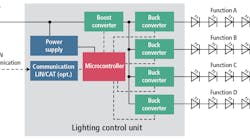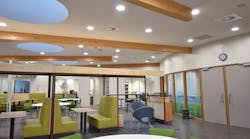St. Augustinus Memory Center hopes that tunable lighting from Osram can rebalance circadian rhythms.
Another dementia center has turned to human-centric lighting (HCL) to help treat patients. This time, the St. Augustinus Memory Center in Neuss, Germany, is trialing tunable lighting from Osram to study the effect of different light frequencies and intensity on patients’ wellbeing and on circadian rhythm, which is an important factor in dementia.
Interested in more articles & announcements on human-centric lighting?
St. Augustinus, also known as AMZ, is a combined hospital and research center. It is outfitting patients’ rooms, patients’ common areas, and public showrooms with smart, tunable lighting using Osram’s Lightify system.
With Osram's Lightify app, users in the healthcare system can program and manage lighting scenes in the human-centric lighting trial. Source: Osram.
Chief physician Ulrich Sprick said AMZ is running three separate trials: one to determine which color temperature is optimal for older people; one to mimic day/night natural lighting patterns and thus support the all-important circadian rhythm; and a third aimed at minimizing falls by experimenting with different levels of lighting intensity that allow patients to see things better.
"With Osram control technology, we're able to check whether we can generate the effects of daylight that we have outside here in the hospital as well,” Dr. Sprick said.
Dementia patients often have difficulty processing light, which in turn disturbs their day–night rhythm and makes it difficult for them to sleep at night. In an experiment to offset this, AMZ will increase light intensity during the day, increasing the chance the patients will process enough light to restore their circadian rhythms to a more typical day–night balance.
In AMZ's tunable lighting setup, Siteco Mira LED luminaires with Tunable White capability can be set to provide daylight stimulation or relxation. Source: Osram.
The trial also includes tunable ceiling lighting in the dining area, where light can alternate between modes that stimulate — such as blue frequencies — and schemes that relax — such as reds and oranges.
Dr. Sprick said the studies should also lead to tunable lighting treatments for other conditions, such as depression and pain.
AMZ is one of the latest examples of human-centric lighting, which tunes LED lights in a manner that offers optimal frequencies, intensities, and temperatures for the time of day and task at hand.
Its experiment echoes the practices in the dementia ward at London’s St. Mary’s hospital and in other locations. In some hospitals, a grassroots call for circadian lighting is coming from within the hospital ranks to help improve patient wellbeing and healing across all areas (not just dementia), such as at the Central Manchester NHS Trust in Manchester, England and at Guy’s and St. Thomas’ NHS Foundation Trust in London.
MARK HALPERis a contributing editor for LEDs Magazine, and an energy, technology, and business journalist ([email protected]).







